Skiing around the tri-state area
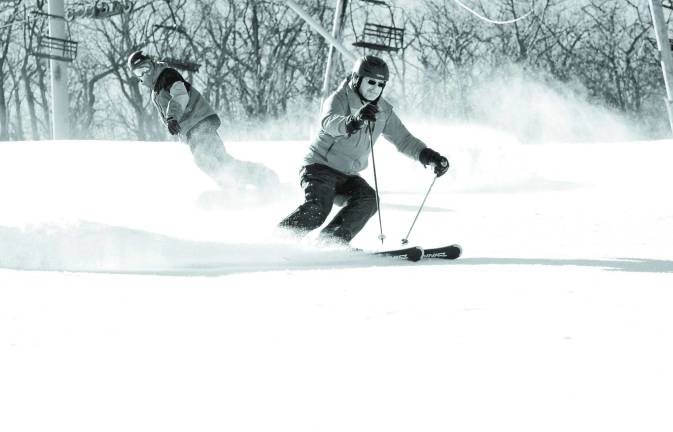
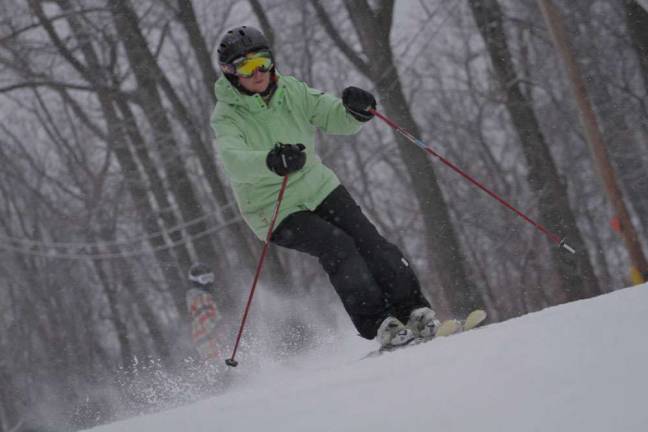
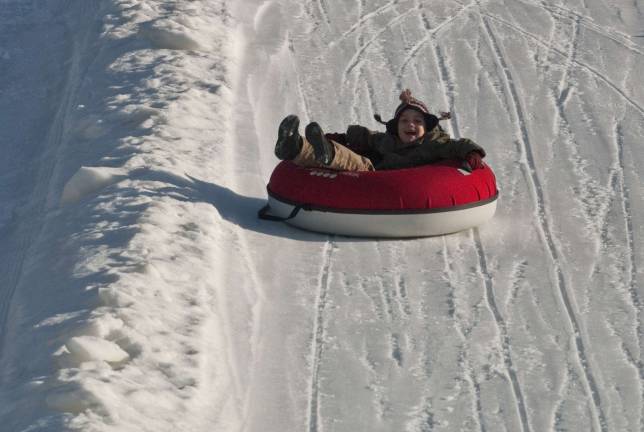
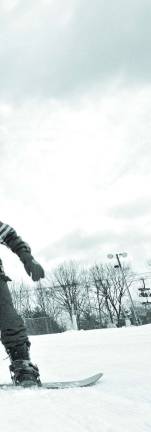
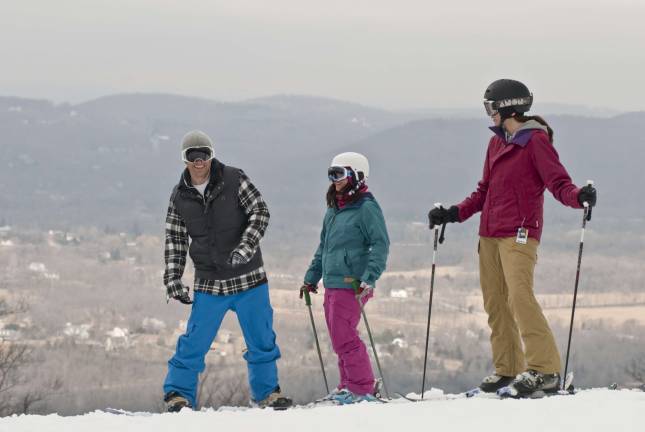
The squirrels have been going a bit nuts and horse owners were reporting December-worthy coats on their equines in October. The buzz is, we're going to have a rough winter. For ski bunnies and boarders, it means lots of time on the slopes. Here is a sampling of some of our area's ski areas.
Located in Vernon, N.J., Mountain Creek offers 167 ski-able acres on four mountain peaks. There is night skiing/snowboarding, and the area boasts the region's highest vertical feet. Its all mountain terrain parks have been rated among the best in both the east and the nation. Mountain Creek South has 17 terrain park trails, 2 high-speed quad lifts, up to 80 features peak season, and a freestyle oriented base lodge with indoor skate bowl.
With a summit elevation of 1,350 feet and vertical change of 700 feet, Shawnee Mountain features 125 acres of skiing terrain. It has 23 trails, nine lifts (one high speed lift called The Tomahawk Express that reaches the summit in three minutes) and two terrain parks, Bushkill Park, which features rails, boxes, a set of stairs and a Tepee Wall Ride and a second one featuring boxes and rails. The mountain features 100 percent snow making and night skiing and snow tubing plus five dining options.
Pass through the Delaware Water Gap into Pennsylvania, and quickly, signs appear for Camelback Mountain. With 100 percent snow coverage over 160 acres, Camelback has 34 trails and 14 lifts.
Tucked away in the New York/New Jersey Highlands region of the Appalachian Mountains, Hidden Valley is known for having one of the best beginner slopes in the area, It also features diverse terrain for the intermediate and advanced all leading to the same base area. Thirteen ski trails drizzle down the mountain and one triple chair, two double chair and one surface lift surmount it. One of Hidden Valley's piece-de-resistances is its slopeside dining and entertainment with both indoor and outdoor seating and two options.
Located in Mahwah, N.J., in northern Bergen County offers 100 percent snow making capabilities and a variety of skiing and snowboarding terrain for all abilities. Campgaw prides itself on short lift lines, uncrowded trails and a friendly staff. In addition, for those who prefer cross country, Campgaw has eight scenic cross-country trails. The mountain's kids skiing lesson program introduces kids to the sport through fun games, and there's night time skiing and snowboarding plus snow sports camps, snow tubing and adult ski workshops.
New Jersey’s first ski area began originally with just one small slope and a rope tow for their families and friends in 1937 on land purchased by Hugo Meury. The ski area was named after Hugo Meury and his wife Helen Craig, the owners, hence the name Craigmeur. In 1942, some white Christmas lights were hung down the side of one of the slopes. These were probably the first lights used for night skiing in New Jersey. Located in Morris County, Craigmeur is a thriving ski area with its own ski club.
Heading out to North Analomink, Penn., Alpine Mountain Ski & Snow Tubing Center touts itself as a "family friendly" ski area and offers 21 trails in varying difficulty.
Another resort, SkyTop Lodge offers a vertical drop of 295 feet — in addition to skiing or riding down their gentle slopes — where guests can also try cross country skiing out to Ladder Falls or Goose Pond. Ski lessons are also available at Skytop's Ski School. Complimentary lift ticket and shuttle come with your stay, and in addition to skiing and boarding, SkyTop features real dog sled rides, sledding and tobogganing, ice skating and even snow shoeing. SkyTop is located just past Canadensis, Penn.
Located in Scranton, Penn., Sno Mountain (formerly Montage Mountain) offers 21 trails and 140 acres of terrain for skiing, snowboarding and snow tubing including a 1.2 mile run. This year, the mountain will kick off the season with the first annual Stoketoberfest 2012, a winter-themed film festival, on Nov. 30 and Dec. 1. Every Stoketober ticket will include a 2012-2013 lift ticket to the mountain.
Over in Palmerton, Penn., Blue Mountain Ski Area is the home of Pennsylvania's highest vertical. With 39 slopes, experts will want to jump on the 3,000 foot Double Black Diamond Trail plus glad trails Sleepy Hollow and Blue Baumer. Intermediates and beginners there is the Burma Road, Lazy Mile and Paradise. Terrain parks and features for freestylers, carvers and tricksters are also offered.
Jack Frost Big Boulder Ski Area has roots dating back to the 1800s. Around 1942, during World War II, the coal industry shifted from underground to surface mining, and it was at that time that the employees built Split Rock Club on the shores of Lake Harmony as a company retreat. The club consisted of Split Rock Lodge and the adjoining Hazzard (Erskine Hazzard) ski slope. When the lodge sold in 1949, Hazzard ski slope became known as Big Boulder Ski Area. This was the first commercial ski resort in Pennsylvania, and it was here that snow making was first used successfully in a commercial application. Today, Jack Frost Ski Area is a companion resort to Big Boulder Ski Area. Jack Frost Mountain provides a summit elevation of 2,000 feet, base elevation of 1,400 feet and vertical drop of 600 feet. Twenty-one different slopes to include: ski school learning slope, four beginner slopes, six intermediate slopes, eight advanced slopes and two Terrain Parks.
Ski Big Bear offers 18 trails, six lifts including two "Magic Carpet" lifts, and 650 feet of vertical. The mountain is covered annually with approximately 50 inches of snow. On Jan. 6 a free ski day will be offered. A Race Clinic will be held Jan. 13, and Ski Big Bear's Winter Carnival will be held Jan. 27.
Located in Mercersburg, Penn., one of Whitetail Mountain Resort's specialties offers a New Year's Eve celebration that features a full buffet dinner, live entertainment from the band E3, magician Deann Burkett, skiing and snowboarding until 1 a.m. and a ball drop at midnight. Reservations are required. Whitetaill has a vertical drop of 935 feet with its top elevation being 1.800 feet. There are 23 trails and nine lifts, 100 percent snow making, a half pipe, two terrain parks and night skiing every evening.
Near the Orange County, N.Y. area, Tuxedo Ridge Ski Center at Sterling Forest features — in addition to downhill — snowboarding, snow tubing and summer events. With seven trails plus the Kitty Slope Beginner Area, Tuxedo Ridge has NASTAR Racing, night skiing on all trails, 100 percent snow making four chair lifts, a snow tubing park and is situated on 100 acres nestled in over 25,000 acres of Sterling Forest State Park.
Celebrating its 77th Anniversary, Mount Peter is located in Southern New York in the heart of the Hudson Valley and is known for its free Beginner Ski and Snowboard School. Mount Peter was started in 1936 by Macy's Department Store to show off and sell the store's ski fashions. It is the oldest operating ski area in New York State and one of the few remaining family operated ski areas in the country.
Located in Highmount, N.Y., Belleayre Mountain was declared “Forever Wild” by the New York State Forest Preserve in 1885. In the 1940s skiing enthusiasts pressured politicians to develop Belleayre, and in 1947 bills were introduced allowing New York State to create Belleayre Mountain. Construction began in 1949 and Belleayre began its winter season with five trails, an electrically powered rope tow, New York’s first chair lift and a summit lodge. It would become the center for winter sports in the region and an economic catalyst for surrounding communities. The mountain includes the only Catskills Cat-access skiing and snowboarding.
The story behind snow making
In 1950, three ambitious inventors came up with a machine worthy of Mother Nature's blessing. Art Hunt, Wayne Pierce and Dave Richey invented the snow cannon, and in 1952, Grossinger's Catskill Resort Hotel earned its place in the archives of skiing as the first in the world to use artificial snow.
By the 1970s, snow making achieved a commercial scale. As technology marches on, so has the complexity of snow making. Where once a skilled snow maker operated the equipment, now computers are at the helm and with this advent has come greater precision to ensure that snow guns only operate when conditions for snow making are possible.
Snow making requires water pumps and air compressors that are both very large and very expensive.
The paramount considerations to produce snow are increasing water and energy efficiency and widening the environmental window in which snow can be made. Snow making requires a lot of energy, and it takes roughly 200,000 gallons of water to cover an acre with a depth of one foot.